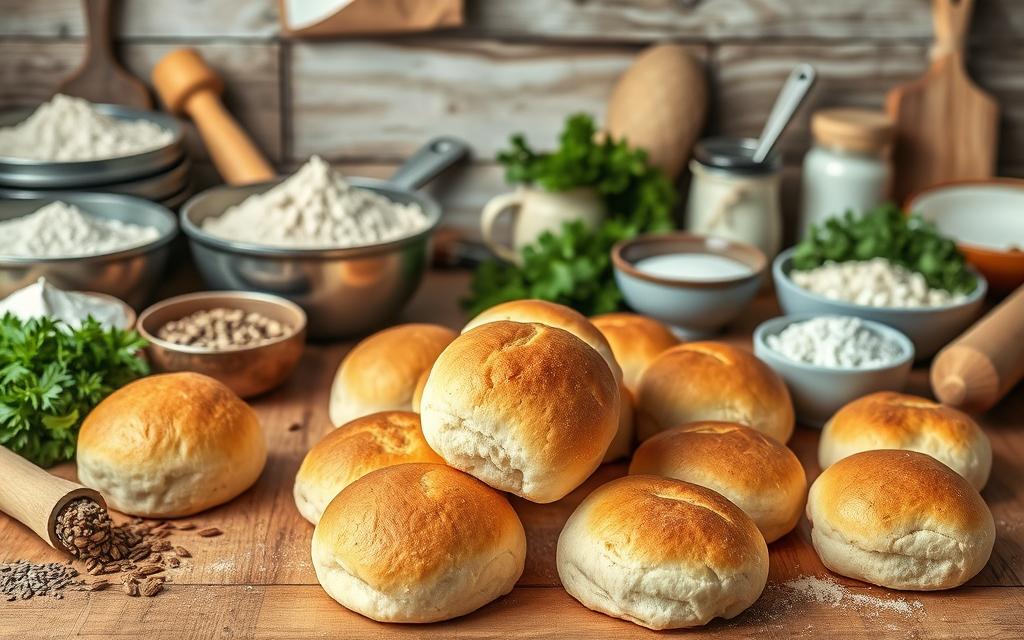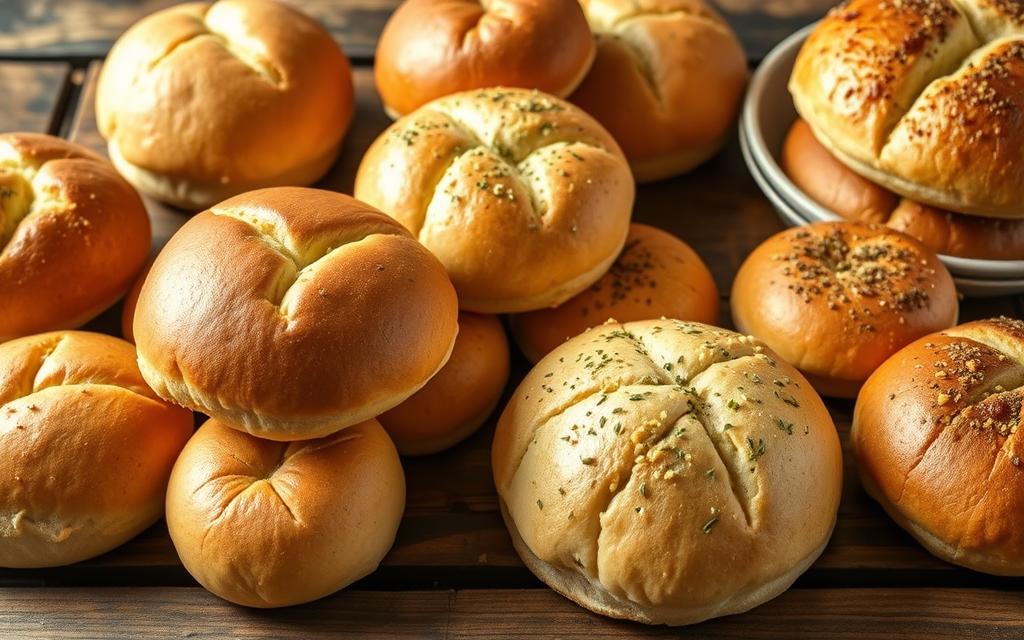Imagine enjoying soft, fluffy dinner rolls without yeast. For those who can’t tolerate yeast, finding alternatives is key. The good news is, you can make dinner rolls without yeast. There are many substitutes that mimic the taste and texture of traditional rolls.
Introduction to Yeast-Free Baking
Exploring yeast-free baking opens up a world of creative options. You can use baking powder or sourdough starter as substitutes. These alternatives make it easy to create delicious dinner rolls, whether you’re in a hurry or prefer a traditional method.
Key Takeaways
- You can make delicious dinner rolls without using yeast
- There are many yeast substitutes available, including baking powder and sourdough starter
- Yeast-free dinner rolls are a great option for those with yeast intolerance or sensitivity
- Dinner roll alternatives can be just as tasty and fluffy as traditional dinner rolls
- Yeast substitutes can be used to make a variety of yeast-free dinner roll recipes
Understanding the Role of Yeast in Dinner Rolls
Yeast is key in baking, making dough rise by producing carbon dioxide gas. This makes bread light and airy, essential for dinner rolls. Using yeast in baking creates a soft, fluffy texture.
The yeast function is complex. It turns sugars into carbon dioxide and ethanol. As it ferments, it makes dough rise. This is why dinner rolls are soft and fluffy inside.
What Does Yeast Do in Baking?
In baking, yeast acts as a leavening agent. It helps dough rise, making bread light and airy. Yeast needs the right conditions to ferment properly. Knowing how yeast works helps us appreciate the texture of rolls.
The Importance of Rising in Rolls
Rising is crucial for a light, airy texture in rolls. Yeast fermentation produces carbon dioxide, making dough rise. This process is vital for dinner rolls, creating a soft interior. Understanding rising helps us see yeast’s role in baking and the challenges of yeast-free alternatives.
Common Yeast Alternatives for Baking
Yeast is key in baking to make dough rise. But, sometimes you might look for other options. Baking powder and a mix of baking soda and vinegar are good choices. They can give your baked goods a similar taste and texture to yeast-based ones.
Baking powder can replace yeast in many recipes. It’s a blend of baking soda and an acid that makes dough rise. Baking soda and vinegar, on the other hand, work together to create a light, airy texture, just like yeast.
Using baking powder and the baking soda and vinegar mix has its perks. They’re easy to find and use, making them perfect for quick baking needs. They work well in various recipes, from dinner rolls to quick breads. Knowing how to use these alternatives can help you make tasty treats with ease.
Baking Powder as a Substitute
Baking powder is a favorite for yeast-free baking. It’s simple to use and can be swapped in many recipes. Just replace the yeast with the right amount of baking powder and follow the recipe.
Baking Soda and Vinegar Combination
The baking soda and vinegar mix is another excellent choice for yeast-free baking. It makes dough light and airy, just like yeast. To use it, mix baking soda and vinegar in your recipe. The acid in the vinegar reacts with the baking soda, making the dough rise.
Using Sourdough Starter as a Guide
A sourdough starter is a great choice for making dinner rolls without yeast. It’s a mix of wild yeast and bacteria that makes the dough rise. This process gives the rolls a sour taste and a soft texture.
To start with sourdough, you need to know how it works. The yeast and bacteria in the starter eat the dough’s sugars. This makes the dough rise, but it takes time. With the right tips, you can make a starter that helps you bake tasty rolls.
How Sourdough Acts as a Leavening Agent
Using sourdough starter involves a few steps. First, you must create and care for a healthy starter. This means feeding it often and letting it ferment. When your starter is active, you can use it to make your dough rise.
Tips for Incorporating Sourdough
Here are some tips for using sourdough starter:
- Feed your starter regularly to keep it healthy and active
- Use the right ratio of starter to flour and water
- Allow the dough to ferment for the right amount of time
- Be patient and don’t overmix the dough
By following these tips, you can make delicious dinner rolls with sourdough starter. The starter will give your rolls a special flavor and texture.
Exploring Quick Bread Recipes
When baking, you can choose between yeast-based recipes and quick breads. Quick breads use baking powder or baking soda, not yeast. This makes them quicker to prepare and bake.
Quick breads differ mainly in their leavening agents. They use baking powder or baking soda, unlike yeast-based recipes. This simplifies the recipe and cuts down preparation time. Try making banana bread, pumpkin bread, or zucchini bread at home. These are great for beginners because they need only a few ingredients and are easy to make.
Here are some tips for making quick bread recipes:
- Use the right type of flour: All-purpose flour is a good choice for most quick bread recipes.
- Don’t overmix: Mix the ingredients just until they are combined, as overmixing can lead to a dense bread.
- Use the right leavening agent: Baking powder or baking soda will help your quick bread rise and give it a light texture.
With these tips and a few simple recipes, you can start exploring the world of quick breads. Enjoy the convenience and deliciousness they offer.
| Recipe | Ingredients | Prep Time |
|---|---|---|
| Banana Bread | Flour, sugar, eggs, bananas | 10 minutes |
| Pumpkin Bread | Flour, sugar, eggs, pumpkin puree | 15 minutes |
| Zucchini Bread | Flour, sugar, eggs, zucchini | 10 minutes |
Utilizing Buttermilk for Leavening
Buttermilk is a great substitute for yeast in baking. It makes dough light and airy. This is because buttermilk has lactic acid, which reacts with baking soda to create carbon dioxide gas.
This reaction is key in buttermilk baking. It helps make the dough tender and flaky.
In buttermilk baking, the buttermilk’s acidity breaks down flour starches. This makes the dough more tender. Buttermilk rolls are a perfect example. They use buttermilk, flour, sugar, and baking soda to create a delicious bread.
How Buttermilk Works in Baking
Buttermilk reacts with baking soda to produce carbon dioxide gas. This gas gets trapped in the dough, making it rise. This process is faster than yeast, ideal for quick breads and rolls.
When using buttermilk, its acidity affects the flavor and texture of the final product.
Recipes Featuring Buttermilk Rolls
Many recipes use buttermilk rolls as the main ingredient. Here are a few:
- Classic buttermilk rolls: These are a staple in many bakeries. They’re made with buttermilk, flour, sugar, and baking soda.
- Buttermilk dinner rolls: Perfect for serving with meals. They can be made with herbs and spices.
- Sweet buttermilk rolls: Great for breakfast or as a snack. They can include sugar, honey, or fruit.
Using buttermilk in baking creates delicious and tender breads and rolls. Whether you’re making classic rolls or something unique, buttermilk is a great choice for bakers.
| Recipe | Ingredients | Instructions |
|---|---|---|
| Classic Buttermilk Rolls | Buttermilk, flour, sugar, baking soda | Mix ingredients, let rise, bake at 375°F for 15-20 minutes |
| Buttermilk Dinner Rolls | Buttermilk, flour, sugar, baking soda, herbs and spices | Mix ingredients, let rise, bake at 375°F for 15-20 minutes |
| Sweet Buttermilk Rolls | Buttermilk, flour, sugar, baking soda, sweet ingredients | Mix ingredients, let rise, bake at 375°F for 15-20 minutes |
The Role of Egg in Yeast-Free Baking
Eggs are key in yeast-free baking, adding structure and texture. The protein in eggs strengthens the dough, making it tender and chewy. They also add moisture, keeping the dough soft and hydrated. It’s important to know how to use eggs well in baking.
In yeast-free baking, egg importance is huge. Eggs help mix ingredients together, making a solid dough. The egg usage in recipes can change, but using them right is key for the right texture. Eggs can replace yeast, add moisture, or act as a binder.
Here are some tips for using eggs well in yeast-free baking:
- Use room temperature eggs for better mixing and incorporation.
- Don’t overmix the dough, as this can lead to a tough and dense texture.
- Experiment with different egg in baking ratios to find the perfect balance for your recipe.

Understanding eggs’ role in yeast-free baking and using them right can make delicious, tender treats. Whether you’re experienced or new, trying different egg usage can improve your baking.
| Egg Usage | Benefits |
|---|---|
| Binding agent | Helps hold ingredients together |
| Moisture addition | Keeps dough hydrated and tender |
| Structure creation | Helps create a tender and chewy texture |
Creative Vegetable Purees as Substitutes
Vegetable purees can change the game for yeast-free dinner rolls. They add moisture, flavor, and texture to the dough. You can try different purees like pumpkin or sweet potato for a unique taste.
Blending flavors is key with vegetable purees. Mixing different purees can create a complex and delicious taste. For instance, roasted garlic and carrot puree mix for a savory and sweet flavor. The art of blending flavors is all about experimenting and being patient.
Some favorite purees for dinner rolls include:
- Pumpkin puree, which adds a warm and comforting flavor
- Sweet potato puree, which provides a sweet and nutty flavor
- Carrot puree, which adds a pop of color and a subtle sweetness
These purees can be used alone or mixed to create a unique flavor. By experimenting with different vegetable purees, you can make delicious and visually appealing yeast-free dinner rolls.
Exploring vegetable purees is all about having fun and being creative. Don’t hesitate to try new combinations and flavors. With practice and patience, you can master blending flavors and make tasty yeast-free dinner rolls.
| Puree | Flavor Profile | Texture |
|---|---|---|
| Pumpkin puree | Warm and comforting | Smooth and creamy |
| Sweet potato puree | Sweet and nutty | Soft and fluffy |
| Carrot puree | Subtly sweet and earthy | Light and airy |
Fermented Ingredients as Alternatives
Fermented ingredients can be a great choice for yeast-free dinner rolls. Foods like kimchi or sauerkraut have lactic acid. This acid reacts with baking soda, creating carbon dioxide gas.
This reaction makes the dough light and airy. You can make delicious dinner rolls with different fermented ingredients.
- Kimchi: a Korean fermented cabbage dish that adds a spicy kick to dinner rolls
- Sauerkraut: a fermented cabbage dish that adds a tangy flavor to dinner rolls
- Miso: a fermented soybean paste that adds a rich, savory flavor to dinner rolls
Using fermented ingredients can make your dinner rolls more complex and flavorful. You can also use sourdough starter as a natural yeast substitute. This way, you can make unique and tasty dinner rolls for any event.
With some creativity and experimentation, you can find many fermented ingredients for your dinner rolls. So, why not try it and see what amazing dishes you can make?
| Fermented Ingredient | Flavor Profile | Usage |
|---|---|---|
| Kimchi | Spicy, sour | Add to dough for a spicy kick |
| Sauerkraut | Tangy, sour | Use as a topping or mix into dough |
| Miso | Rich, savory | Use as a substitute for salt or sugar |
Gluten-Free Options for Dinner Rolls
Gluten-free dinner rolls offer a variety of choices. Gluten-free baking can be tricky, but the right ingredients and techniques make delicious rolls. Almond flour and coconut flour are key for these rolls.
Key Ingredients for Gluten-Free Rolls
To make gluten-free rolls, mix gluten-free flours like rice, potato, and tapioca. Add xanthan or guar gum for texture. Eggs, sugar, and yeast enhance flavor and texture.
Flavor Considerations in Gluten-Free Baking
Gluten-free baking needs flavor adjustments. Gluten-free flours are denser, so more liquid is needed. Herbs and spices add flavor. Try garlic and rosemary or olive oil and sea salt.
Some popular gluten-free options for dinner rolls include:
- Gluten-free rolls made with almond flour and coconut flour
- Gluten-free rolls made with rice flour and potato starch
- Gluten-free rolls made with tapioca flour and xanthan gum

Follow these tips and use the right ingredients for tasty gluten-free dinner rolls. They’re great for health or personal preference. With practice, you’ll master gluten-free baking and enjoy these rolls often.
Conclusion: Getting Creative in the Kitchen
The world of yeast-free dinner rolls is full of creative options. By trying new things, you can make unique and tasty rolls. Whether you like sourdough, buttermilk, or vegetable purees, the key is to have fun.
Embracing Experimentation
Don’t be scared to try new ingredients or methods. Mix different flours, fats, and leavening agents to find what you like. The fun is in the journey, not just the end result.
Final Tips for Perfecting Dinner Rolls
Keep these tips in mind as you cook: watch the texture and rise of your rolls. Don’t be afraid to change recipes to fit your taste. Most importantly, enjoy the process. With creativity and a bit of experimentation, you’ll make amazing yeast-free dinner rolls.

